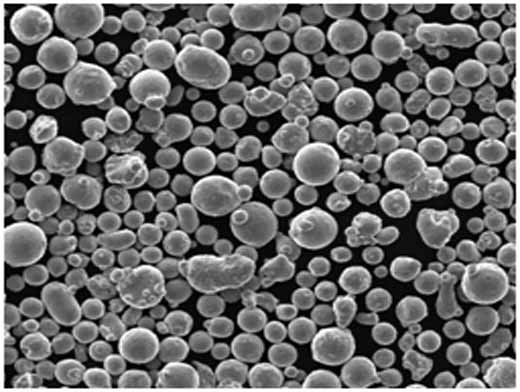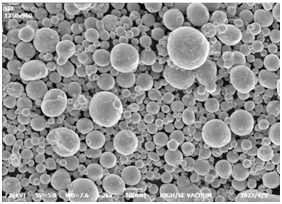구리는 인류 문명의 초석으로 전기 공학, 건설 및 많은 산업 분야에서 필수적인 역할을 해왔습니다. "고순도 구리 분말'라는 슬로건 아래 순도와 성능의 한계를 뛰어넘는 소재의 영역으로 뛰어들고 있습니다. 고순도 구리 분말은 단순한 소재가 아니라 전도성, 내식성, 열 관리 등 여러 가지 특성에서 탁월한 품질을 제공하는 특수한 형태의 구리입니다. 이 글에서는 고순도 구리 분말의 구성과 특성부터 다양한 응용 분야와 시중에 나와 있는 다양한 모델에 이르기까지 고순도 구리 분말에 대해 알아야 할 모든 것을 살펴봅니다. 이 가이드가 끝나면 이 놀라운 소재에 대한 포괄적인 이해와 함께 프로젝트에 어떤 이점을 제공할 수 있는지 알게 될 것입니다.
고순도 구리 분말 개요
고순도 구리 분말은 일반적으로 순도가 99.9%를 초과하는 분말 형태의 구리를 말합니다. 이 분말은 우수한 전도성, 가단성 및 내식성으로 인해 전자, 야금, 화학 공학 및 첨단 제조를 포함한 다양한 산업 분야에서 사용됩니다. 고순도 구리 분말을 생산하려면 전기분해, 화학적 환원, 원자화 등 여러 가지 정교한 공정이 필요하며, 각 공정은 재료의 순도와 일관성을 보장합니다.
성능에 타협해서는 안 되는 첨단 기술 분야에서 고순도 구리 분말은 탁월한 특성으로 두각을 나타내고 있습니다. 이 가이드는 고순도 구리 분말의 다양한 유형, 구성, 특정 특성 및 잠재적 용도와 함께 장점과 한계에 대한 분석을 심층적으로 살펴보는 것을 목표로 합니다.

고순도 구리 분말의 종류
다양한 유형의 고순도 구리 분말은 특정 용도에 맞게 맞춤 제작됩니다. 아래는 주요 유형과 고유한 특성을 요약한 표입니다.
| 유형 | 순도 수준 | 입자 크기(µm) | 생산 방법 | 애플리케이션 |
|---|---|---|---|---|
| 전해 구리 분말 | 99.99% | 1-10 µm | 전해 정제 | 전자, 소결 |
| 원자화된 구리 분말 | 99.95% | 5-50 µm | 원자화 프로세스 | 3D 프린팅, 열 관리 |
| 구리 분말 감소 | 99.9% | 10-100 µm | 화학 물질 감소 | 야금, 촉매 |
| 침전 구리 분말 | 99.95% | 0.5-10 µm | 침전 방법 | 전도성 페이스트, 전자 제품 |
| 나노 분말 구리 | 99.999% | <100nm | 화학 합성 | 나노 기술, 고정밀 부품 |
| 구형 구리 분말 | 99.9% | 15-45 µm | 가스 분무 | 적층 제조, 전도성 잉크 |
| 플레이크 구리 분말 | 99.9% | 1-15 µm | 밀링 | 전도성 코팅, 윤활제 |
| 입상 구리 분말 | 99.95% | 50-150 µm | 과립화 | 분말 야금, 베어링 |
| 초고순도 구리 분말 | 99.9999% | 1-5 µm | 특수 전해 정제 | 반도체 제조 |
| 미세 구리 분말 | 99.97% | 5-20 µm | 기계적 분쇄 | 표면 코팅, 용접 재료 |
구성 고순도 구리 분말
고순도 구리 분말의 구성은 거의 전적으로 구리이지만, 존재하는 미량 원소는 그 특성과 성능에 상당한 영향을 미칠 수 있습니다. 구리의 성분을 이해하면 특정 용도에 적합한 유형을 선택하는 데 도움이 됩니다.
| 구성 요소 | 일반적인 농도 | 속성에 미치는 영향 |
|---|---|---|
| 구리(Cu) | 99.9% – 99.9999% | 뛰어난 전기 및 열 전도성 제공 |
| 산소(O) | <0.001% | 수치가 높을수록 전도도가 감소하고 산화가 촉진될 수 있습니다. |
| 철(Fe) | <0.0005% | 낮은 수위는 부식을 방지하고 연성을 유지하는 데 매우 중요합니다. |
| 납(Pb) | <0.0001% | 환경 및 건강 위험을 피하기 위해 최소화해야 합니다. |
| 유황(S) | <0.0002% | 유연성 및 전반적인 성능에 영향을 미칩니다. |
| 은(Ag) | <0.0005% | 전도성 및 내식성 향상 가능 |
고순도 구리 분말의 특성
고순도 구리 분말의 특성은 수많은 첨단 응용 분야에서 없어서는 안 될 필수 요소입니다. 아래에서는 성능을 정의하는 가장 중요한 특성 몇 가지를 자세히 설명합니다.
1. 전기 전도도
고순도 구리 분말은 전기 전도성이 뛰어나 전기 접점 및 전도성 잉크와 같이 효율적인 전자 흐름이 필요한 분야에 자주 사용되는 것으로 유명합니다.
2. 열 전도성
열을 효율적으로 전도하는 구리의 특성 때문에 고순도 구리 분말은 방열판 및 기타 열 관리 부품, 특히 전자 제품에서 선호되는 소재입니다.
3. 내식성
고순도 구리 분말은 전도성이 뛰어나면서도 황과 철과 같은 불순물이 없는 경우 특히 부식에 대한 저항성이 뛰어납니다.
4. 연성 및 가단성
고순도 구리 분말의 연성과 가단성 덕분에 소결 및 적층 제조 공정에서 필수적인 균열 없이 복잡한 모양으로 성형할 수 있습니다.
5. 순도 수준
순도 수준은 성능에 직접적인 영향을 미치며, 초고순도 구리 분말(순도 99.9999%)은 아주 작은 불순물에도 심각한 결함이 발생할 수 있는 반도체 제조 분야에 필수적입니다.






장점 고순도 구리 분말
고순도 구리 분말을 선택하면 특히 고성능 애플리케이션에서 저순도 옵션에 비해 여러 가지 이점이 있습니다. 몇 가지 이점을 자세히 살펴보세요.
| 이점 | 설명 |
|---|---|
| 뛰어난 전기 전도성 | 전기 및 전자 부품의 효율적인 전류 흐름을 보장합니다. |
| 높은 열 전도성 | 고전력 장치 및 열 관리 시스템의 열 방출에 이상적입니다. |
| 내식성 | 부식성 환경에서도 오래 지속되는 성능으로 유지보수 비용을 절감할 수 있습니다. |
| 향상된 연성 | 전자제품의 마이크로 부품에 필수적인 복잡한 디자인으로 쉽게 성형할 수 있습니다. |
| 초순수 등급 사용 가능 | 순도가 중요한 반도체 및 나노 기술 애플리케이션에 사용하기에 적합합니다. |
고순도 구리 분말의 응용 분야
고순도 구리 분말은 다양한 산업 분야에서 무수히 많은 용도로 사용됩니다. 다음은 가장 일반적인 용도를 요약한 표입니다.
| 산업 | 애플리케이션 | 사용되는 구리 분말의 종류 |
|---|---|---|
| 전자 제품 | 전도성 잉크, PCB, EMI 차폐 | 나노 분말 구리, 전해 구리 분말 |
| 적층 제조 | 금속 부품의 3D 프린팅 | 구형 구리 분말, 분무형 구리 분말 |
| 야금학 | 소결, 분말 야금 | 입상 구리 분말, 환원 구리 분말 |
| 항공우주 | 열 관리 구성 요소 | 초고순도 구리 분말 |
| 자동차 | 브레이크 패드, 베어링 | 미세 구리 분말, 플레이크 구리 분말 |
| 나노 기술 | 고정밀 장치 | 나노 분말 구리 |
| 의료 기기 | 항균 코팅 | 침전 구리 분말 |
| 재생 에너지 | 태양 전지 부품 | 전해 구리 분말 |
| 용접 | 브레이징 페이스트, 용접봉 | 미세 구리 분말, 입상 구리 분말 |
| 화학 공학 | 촉매제 | 환원 구리 분말, 침전 구리 분말 |
고순도 구리 분말의 사양, 크기, 등급 및 표준
특정 용도에 맞는 고순도 구리 분말을 선택할 때는 사양, 크기, 등급 및 표준을 이해하는 것이 중요합니다. 아래는 이러한 매개변수를 요약한 자세한 표입니다.
| 사양 | 범위/등급 | 표준 | 크기 옵션 |
|---|---|---|---|
| 순도 | 99.9% – 99.9999% | ASTM B170, ISO 431 | 사용자 지정 가능(1µm - 150µm) |
| 입자 크기 | 0.1µm - 150µm | ASTM E11 | 미세, 거친, 나노 입자 |
| 모양 | 구형, 플레이크, 세분화 | ASTM B822 | 다양한 모양 사용 가능 |
| 밀도 | 2.0 - 8.9 g/cm³ | ISO 3923 | 벌크 밀도, 탭 밀도 |
| 흐름성 | 5 - 25초/50g | ISO 4490 | 자유 흐름, 비자유 흐름 |
| 산소 함량 | <0.001% | ISO 5832 | 초저산소 옵션 |
| 전도성 | > 99% IACS | ASTM B193 | 높은 전도성 등급 |
고순도 구리 분말의 공급업체 및 가격 세부 정보
고순도 구리 분말을 구매하려면 공급업체의 평판과 가격 구조를 모두 고려해야 합니다. 아래는 주요 공급업체의 세부 정보와 가격을 요약한 표입니다.
| 공급업체 | 제품 | 가격 범위(kg당) | 최소 주문 수량(MOQ) | 위치 |
|---|---|---|---|---|
| 미국 요소 | 초고순도 구리 분말 | $500 – $700 | 1kg | 미국 |
| 호가나스 AB | 원자화된 구리 분말 | $300 – $500 | 5kg | 스웨덴 |
| Tekna | 구형 구리 분말 | $400 – $600 | 2kg | 캐나다 |
| 미쓰이 광업 및 제련 | 전해 구리 분말 | $250 – $450 | 10kg | 일본 |
| 유미코어 | 나노 분말 구리 | $700 – $1000 | 0.5kg | 벨기에 |
| 상하이 CNPC | 구리 분말 감소 | $200 – $400 | 20kg | 중국 |
| GGP 메탈 파우더 | 플레이크 구리 분말 | $150 – $350 | 15kg | 인도 |
| 키메라 인터내셔널 | 입상 구리 분말 | $300 – $550 | 3kg | 미국 |
| 나노케미존 | 침전 구리 분말 | $450 – $650 | 1kg | 캐나다 |
| 스미토모 금속 광업 | 미세 구리 분말 | $350 – $550 | 5kg | 일본 |
고순도 구리 분말의 장점과 한계
고순도 구리 분말의 장단점을 모두 이해하면 구리 분말 사용에 대한 현명한 결정을 내리는 데 도움이 될 수 있습니다.
| 장점 | 제한 사항 |
|---|---|
| 뛰어난 전도성 | 더 높은 비용: 초고순도 등급은 가격이 비쌀 수 있습니다. |
| 높은 열 관리 | 산화: 부식에 강하지만 시간이 지나면 산화될 수 있습니다. |
| 뛰어난 가단성 | 분말 처리: 미세 분말은 취급 및 가공에 어려움을 겪을 수 있습니다. |
| 내식성 | 가용성: 일부 고순도 등급은 공급업체에 따라 이용 가능 여부가 제한될 수 있습니다. |
| 광범위한 적용 범위 | 건강 위험: 나노 분말은 잠재적인 건강 위험으로 인해 취급 시 주의가 필요합니다. |

자주 묻는 질문
| 질문 | 답변 |
|---|---|
| 고순도 구리 분말은 어떤 용도로 사용되나요? | 고순도 구리 분말은 우수한 전기적 및 열적 특성으로 인해 전자, 야금, 적층 제조, 나노 기술 등에 사용됩니다. |
| 고순도 구리 분말은 어떻게 만들어지나요? | 전기분해, 화학적 환원, 원자화, 침전 등의 방법을 통해 생산되어 높은 순도를 보장합니다. |
| 어떤 순도 수준을 사용할 수 있나요? | 순도 수준은 일반적으로 애플리케이션에 따라 99.9%에서 99.9999%까지 다양합니다. |
| 고순도 구리 분말이 비싼 이유는 무엇인가요? | 이 비용은 고순도를 달성하는 데 필요한 정교한 생산 공정과 첨단 기술에서 구리의 중요한 역할을 반영합니다. |
| 3D 프린팅에 고순도 구리 분말을 사용할 수 있나요? | 예, 구형 고순도 구리 분말은 금속 부품을 만들기 위한 적층 제조에 널리 사용됩니다. |
| 고순도 구리 분말은 취급해도 안전한가요? | 일반적으로 안전하지만 나노 분말은 흡입 위험이 있으므로 주의해서 취급해야 합니다. 적절한 안전 프로토콜을 따라야 합니다. |
| 고순도 구리 분말은 어디에서 구입할 수 있나요? | American Elements, Höganäs AB, Tekna 등 여러 공급업체에서 고순도 구리 분말을 제공합니다. 가격은 순도, 입자 크기 및 공급업체에 따라 다릅니다. |
| 고순도 구리 분말의 대안은 무엇인가요? | 전도성을 위한 은 분말, 경량 애플리케이션을 위한 알루미늄 분말, 특정 산업 용도를 위한 니켈 분말 등이 대안이 될 수 있습니다. |
| 순도는 구리 분말의 특성에 어떤 영향을 미치나요? | 순도가 높을수록 전기 및 열 전도성, 내식성, 연성이 향상되어 하이테크 애플리케이션에 이상적입니다. |
| 고순도 구리 분말을 사용할 때 어떤 어려움이 있나요? | 비용 증가, 산화 가능성, 초미세 분말의 취급 문제 등이 해결해야 할 과제입니다. |
결론
고순도 구리 분말 은 정밀성, 효율성, 신뢰성이 요구되는 산업에 필수적인 소재입니다. 고성능 전자 부품을 만들거나 3D 프린팅과 같은 첨단 제조 기술을 구현하거나 항공우주 분야에서 열 관리를 강화하는 등 고순도 구리 분말의 역할은 아무리 강조해도 지나치지 않습니다. 다양한 유형, 구성, 특성 및 응용 분야를 이해하면 특정 요구 사항에 적합한 재료를 선택하는 데 도움이 될 수 있습니다. 비용과 취급 문제로 인해 몇 가지 제한이 있을 수 있지만, 고순도 구리 분말 사용의 이점은 특히 품질에 타협할 수 없는 고성능 애플리케이션에서 이러한 단점보다 더 큰 경우가 많습니다.
기술이 계속 발전함에 따라 고순도 구리 분말과 같은 소재에 대한 수요는 계속 증가할 것입니다. 최신 발전과 공급업체에 대한 정보를 지속적으로 파악하면 최고의 재료로 제품을 제작할 수 있는 경쟁력을 확보할 수 있습니다.

